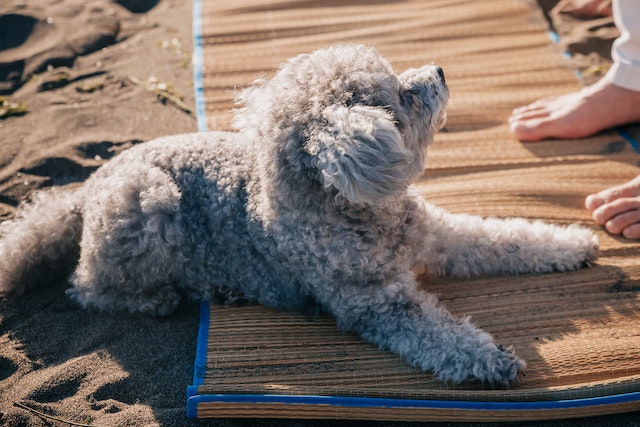As a dog owner, it’s essential to understand the importance of keeping your furry friend’s coat in good condition. Dogs with long hair are particularly susceptible to matting, a condition where the fur becomes tangled and clumps together, leading to discomfort and even pain for your pet. In this blog post, we’ll discuss matting in dogs, how to prevent it, and how to treat it if it does occur.

What is Matting in Dogs?
Matting in dogs is a condition where the fur becomes tangled and forms tight clumps. This can occur in any breed of dog with long hair, but it’s more common in breeds such as Poodles, Maltese, Yorkshire Terriers, and Shih Tzus.
Matting can occur anywhere on a dog’s body, but it’s most common around the ears, under the legs, and around the tail. These areas are more prone to matting because they have more friction against the ground or furniture, and they are harder for dogs to reach and groom themselves.
The Causes of Matting in Dogs
Matting can occur for a variety of reasons. One of the most common causes is neglecting to brush your dog’s coat regularly. Brushing is essential for removing tangles and preventing matting from occurring. If you don’t brush your dog’s coat regularly, dead hair and dirt can build up, creating mats.
Another cause of matting is moisture. When a dog’s fur gets wet, it can be harder to brush and groom, and mats can form. Dogs that swim or get wet in the rain are more susceptible to matting, and it’s essential to dry their coat thoroughly to prevent matting from occurring.
Finally, dogs with long hair can also experience matting due to their hair rubbing against furniture, carpets, or other surfaces. This constant friction can cause tangles and mats, particularly in areas where the hair is longer and thicker.
The Dangers of Matting in Dogs
Matting is more than just an aesthetic issue for dogs. It can be uncomfortable and even painful for them. Mats can pull on the skin, causing irritation and even sores. They can also trap moisture, leading to skin infections, and they can make it difficult for dogs to move or lie down comfortably.
Severe matting can also lead to health problems. It can prevent air from reaching the skin, leading to hot spots, fungal or bacterial infections, and even maggots. These conditions can be painful and may require veterinary treatment.
Preventing Matting in Dogs
Preventing matting in dogs is easier than treating it once it occurs. Regular grooming is the key to preventing mats from forming. Depending on the breed, you may need to groom your dog daily or weekly. This includes brushing and combing their coat thoroughly, paying attention to areas that are more prone to matting, such as under the legs, around the ears, and around the tail.
It’s also important to keep your dog’s coat clean and dry. If your dog gets wet, make sure to dry their coat thoroughly, and consider using a dog-specific hairdryer to speed up the process. Avoid leaving your dog outside in the rain or wet grass for extended periods, as this can lead to matting.
If your dog is prone to matting, consider keeping their hair trimmed short. This will make grooming easier and prevent mats from forming.
Treating Matting in Dogs
If your dog does develop mats, it’s important to address the issue promptly. Small mats can often be brushed out with a comb or brush, but larger mats may require more intensive treatment.
The first step in treating mats is to identify their location and severity. If the mats are close to the skin or have been present for a while, it’s best to take your dog to a professional groomer or veterinarian. Attempting to cut or shave out mats yourself can be dangerous, as you may accidentally cut your dog’s skin.
Professional groomers have the tools and experience necessary to safely remove mats without hurting your dog. They may use clippers, scissors, or special detangling sprays to carefully remove the mats without injuring your pet.
In severe cases, mats may need to be shaved off completely. While this can be a drastic solution, it may be necessary to prevent further discomfort or infection.
After your dog has been treated for mats, it’s important to establish a regular grooming routine to prevent them from recurring. Regular brushing and combing, along with keeping your dog’s coat clean and dry, can go a long way in preventing mats from forming again.
Conclusion
Matting is a common issue for dogs with long hair, but it can be easily prevented with regular grooming and care. Neglecting to groom your dog’s coat can lead to uncomfortable and painful mats, which can cause serious health issues if left untreated.
By establishing a regular grooming routine, keeping your dog’s coat clean and dry, and monitoring for signs of matting, you can prevent this condition from occurring in your pet. And if mats do develop, seek the help of a professional groomer or veterinarian to ensure your pet’s safety and comfort.
Remember, a well-groomed dog is a happy and healthy dog! Click here to learn more.
Thank you for reading
We will be posting in-depth blog posts related to dog grooming, dog breeds, dog training tips, and much more. Don’t forget to tag us on Instagram or follow our FaceBook page!



